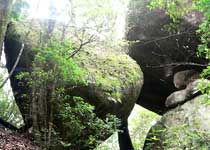Attration Category
Sanming Weather

Even though it seems that spring will never arrive and residents in Xiamen can feel the winter chill. You may be seeking outdoor fun to tone up your winter. How about watching the flocks of migrant birds in winter? Want to have a taste of a world of singing birds? There are some beautiful birds wintering at Junfeng Mountain Nature Reserve in Mingxi, Sanming, Fujian.
Junfeng Mountain Nature Reserve, located in Xiayang Village in the east of Mingxi County, Sanming, is a provincial-level nature reserve that covers a total area of 1,710 hectares. Due to the favorable subtropical monsoon climate, the nature reserve attracts different species of migrant birds to spend winter there. This year, about 600,000 migrant birds have flocked to the reserve, including gray-backed thrush, mandarin duck, swan, snipe, etc. Thanks to effective protection, the different species of aquatic life and water birds are enjoying an ideal habitat with plenty of water and vegetation area. The winter's sleep is deep and long in the north. Take the chance to see them before they make their way north to nest.
Wild mandarin duck is a precious species under the second-class protection in China. Most mandarin ducks are so timid that they will hide themselves when hearing a tiny sound. Tourists can only shoot the mandarin ducks from a distance.
The Grey-backed Thrush is a species of bird in the Turdidae family. This species of bird likes to search for food alone or in pairs. They are often found in grass field and woods. Good at singing, the birds usually tweet all day long at a certain place. Tourists can clearly hear their singing afar.
Cygnets are mainly winter visitors at Junfeng Mountain Nature Reserve, majestic and graceful as they sweep across the lake. Experience the haunting calls of these birds as they follow you along the loch shore.
The swans are best seen in the mid-afternoon to dusk hours. During the earlier parts of the day, they are sometimes off looking for food. You may still see a few on the lake, but your chances are better later in the day.
A snipe is characterized by a very long, slender bill and cryptic plumage. Snipe search for invertebrates in the mud with a "sewing-machine" action of their long bills. Most have distinctive displays, usually given at dawn or dusk. Go and enjoy the fun of seeing how a snipe how searches for prey in a wetland.
Tips for bird watching
Birds are active, energetic animals and you need a quick eye to spot as many details as possible in a short span of time. There may be many obstacles. So to stand the best chance, you'll want to know what to look for how to spend your precious viewing time. The followings are four tips for bird watching.
1. Bird photography can be an excellent extension to the hobby of bird watching. So, bring a high mega-pixel digital camera with you.
2. Get a decent pair of binoculars. Buy the best that you can afford. You will be entering a new world of wonder. Binoculars that are comfortable to use and good optically will help prevent eye and neck strain.
3. Use your binoculars the right way. Always take your binoculars with you. You never know what you may see.
4. Use hides where possible. You will get brilliant views of birds that are otherwise hard to see well, and this is an excellent way to become really familiar with their distinctive features.


